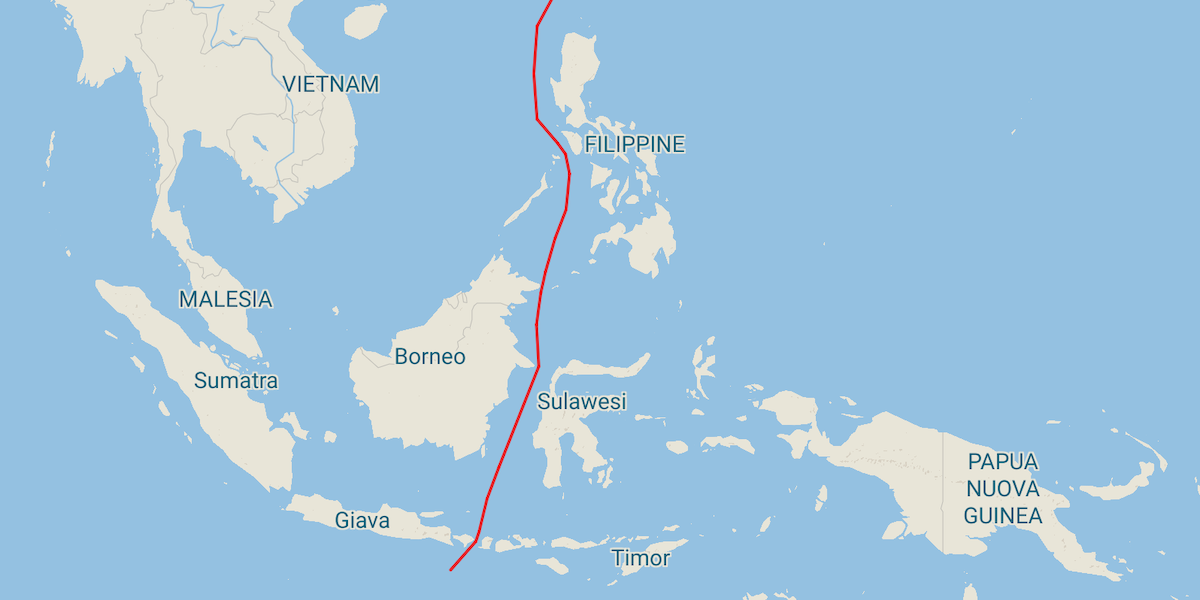He divides neighboring islands but with a completely different fauna: those who “discovered” understand that geology influenced the history of evolution
The most famous imaginary lines that humanity has drawn through the centuries on Earth, or rather on its representations such as globes and globes, do not separate the different geographical regions. If it crosses lines of longitude, whose positions are arbitrary, but also the equator, which is instead where it is by definition (on the parallel corresponding to the maximum circumference of our planet), the surrounding natural features do not change. The same applies to most of the country’s land borders.
However, there is an imaginary line, less well known, which instead corresponds to a great difference between the regions separating it, and which can indeed be said to have been “discovered” precisely because of this difference: it is called the Wallace line and it is located in Southeast Asia, where Indonesia is divided into two parts. To the west of the line live animal species typical of Asia, such as elephants, tigers and rhinos, but also primates such as orangutans, while to the east there are species from Oceania, such as marsupials, the order of mammals to which the kangaroo belongs.
The Wallace line owes its name to Alfred Russell Wallace, the British naturalist whose bicentenary of birth occurred this year and who understood the mechanism of natural selection in the same period as Charles Darwin arrived, but who today is less well known.
In the 1850s, Wallace traveled to the islands that are now part of Indonesia or neighboring countries to study their biology. In a letter dated 1856, addressed to the agent with whom he cooperated to deliver stuffed animals of various kinds to scholars in the United Kingdom, he said that he had noticed an interesting difference between the islands of Bali and Lombok, which are so close to each other: «Zonologically they belong to two distinct provinces, They represent their extreme limits. Indeed, Bali has fauna similar to those found in Borneo and Sumatra, while the species found in Lombok are more similar to those found in the easternmost islands and Australia.
In particular, Wallace notes that bird species so common on the island of Java were very much present in Bali, but missing from Lombok.
The differences in the fauna of the two islands were particularly surprising and difficult to explain given that the Lombok Strait, the stretch of sea separating them, is not very wide: at the closest points, Bali and Lombok are about 35 kilometers apart like a crow. flies. Both are far away from the islands which have similar fauna. And despite the geographical proximity, the differences between the fauna of the Balinese and the Lombok are much greater than those that exist between the fauna of very distant lands, such as Europe and Japan.
Wallace hypothesized that the sea level in the past was low and that the islands were connected to other lands reached by the ancestors of his modern animals; He also thought that perhaps the sea floor of the Lombok Strait was so deep that it was never without water, which is why the fauna of Bali and Lombok remained isolated.
It was unknown in those days that the continents we know were not always where they are today. German geologist Alfred Wegener started talking about continental drift only in 1912 and only in the 1960s, thanks to the progress of marine geology and the development of the theory of plate tectonics, the international scientific community was convinced of the fact that until the year 200 AD. A million years ago, all of the landmass was united into a single supercontinent.
In the 20th century, the study of the earth’s crust showed that Bali and Lombok belong to two different continental shelves, the Sunda platform to the west and the plains platform to the east. Wallace did not know that the two islands more than 20 million years ago were much farther away than they are today, but he still assumed that geology had an influence on their environment, that is, on the distribution of species and the relationships in which they coexisted, and in fact, he found important evidence about geological history. Oceania and the origin of its fauna, which evolved independently from the Asian fauna.
Although today’s Bali and Lombok are very close as the crow flies, and in general there are not very great distances separating many Indonesian islands, the zoological differences have been preserved due to the geological past. It is impossible for terrestrial animals to swim across the deep seas choked by the ocean currents that separate them, and the fierce winds over the ocean prevent even flying insects and birds from crossing the Wallace Line.
It wasn’t Wallace who gave his name to this frontier, but another British naturalist, Thomas Henry Huxley, who was an important proponent of Darwin’s theories and also known as the grandfather of the writer Aldous Huxley. By studying the fauna of the Philippines, Huxley proposed to slightly change the imaginary line drawn by Wallace in his studies, reaching to include the archipelago in the easternmost region, and in 1868 he spoke for the first time of the “Wallace line”.
For his studies, Wallace is now considered the founder of biogeography, the branch of biology devoted to the relationships between the geographic distribution of species and ecosystems and their histories.
– Also read: The glacier that crosses the border between Italy and Switzerland

“Infuriatingly humble social media ninja. Devoted travel junkie. Student. Avid internet lover.”


